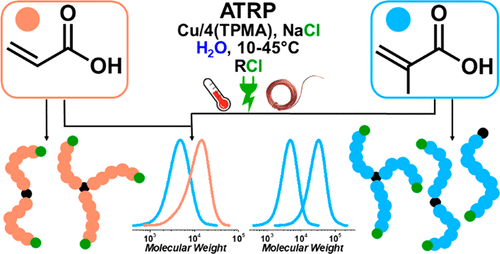当前位置:
X-MOL 学术
›
ACS Macro Lett.
›
论文详情
Our official English website, www.x-mol.net, welcomes your feedback! (Note: you will need to create a separate account there.)
Atom Transfer Radical Polymerization of Acrylic and Methacrylic Acids: Preparation of Acidic Polymers with Various Architectures
ACS Macro Letters ( IF 5.8 ) Pub Date : 2020-04-27 , DOI: 10.1021/acsmacrolett.0c00246 Francesca Lorandi 1, 2 , Marco Fantin 1 , Yi Wang 1 , Abdirisak A Isse 2 , Armando Gennaro 2 , Krzysztof Matyjaszewski 1
ACS Macro Letters ( IF 5.8 ) Pub Date : 2020-04-27 , DOI: 10.1021/acsmacrolett.0c00246 Francesca Lorandi 1, 2 , Marco Fantin 1 , Yi Wang 1 , Abdirisak A Isse 2 , Armando Gennaro 2 , Krzysztof Matyjaszewski 1
Affiliation

|
The preparation of poly(acrylic acid) (PAA) with tailored architecture and morphology is important for the design of advanced polymer materials. Cu-catalyzed atom transfer radical polymerization (ATRP) of AA is challenging due to the tendency of dormant chains to undergo an intramolecular lactonization reaction with consequent loss of chain-end functionalities, as previously reported for ATRP of methacrylic acid (MAA). In addition, AA can coordinate to the Cu catalyst. Moreover, the lower ATRP reactivity of AA relative to MAA enhances side reactions during polymerizations. These issues were overcome by adjusting the composition of the catalytic system, the polymerization setup, and the initiator nature. AA conversion >70–80% was obtained in 5 h, producing PAA with Đ ≈1.4. Multifunctional water-soluble initiators provided PAA and PMAA with telechelic and star-shaped architectures. Block copolymers of MAA and AA confirmed the retention of chain-end functionalities during ATRPs.
中文翻译:

丙烯酸和甲基丙烯酸的原子转移自由基聚合:制备各种结构的酸性聚合物
具有定制结构和形态的聚(丙烯酸)(PAA)的制备对于先进聚合物材料的设计非常重要。AA 的铜催化原子转移自由基聚合 (ATRP) 具有挑战性,因为休眠链倾向于进行分子内内酯化反应,从而导致链端官能团的损失,正如之前报道的甲基丙烯酸 (MAA) 的 ATRP 一样。此外,AA可以与Cu催化剂配位。此外,AA 相对于 MAA 的较低 ATRP 反应性增强了聚合过程中的副反应。这些问题通过调整催化体系的组成、聚合设置和引发剂性质得以克服。在 5 小时内获得 >70–80% 的 AA 转化率,产生具有Đ的 PAA≈1.4。多功能水溶性引发剂为 PAA 和 PMAA 提供了遥爪和星形结构。MAA 和 AA 的嵌段共聚物证实了在 ATRP 过程中链端官能团的保留。
更新日期:2020-04-27
中文翻译:

丙烯酸和甲基丙烯酸的原子转移自由基聚合:制备各种结构的酸性聚合物
具有定制结构和形态的聚(丙烯酸)(PAA)的制备对于先进聚合物材料的设计非常重要。AA 的铜催化原子转移自由基聚合 (ATRP) 具有挑战性,因为休眠链倾向于进行分子内内酯化反应,从而导致链端官能团的损失,正如之前报道的甲基丙烯酸 (MAA) 的 ATRP 一样。此外,AA可以与Cu催化剂配位。此外,AA 相对于 MAA 的较低 ATRP 反应性增强了聚合过程中的副反应。这些问题通过调整催化体系的组成、聚合设置和引发剂性质得以克服。在 5 小时内获得 >70–80% 的 AA 转化率,产生具有Đ的 PAA≈1.4。多功能水溶性引发剂为 PAA 和 PMAA 提供了遥爪和星形结构。MAA 和 AA 的嵌段共聚物证实了在 ATRP 过程中链端官能团的保留。


























 京公网安备 11010802027423号
京公网安备 11010802027423号